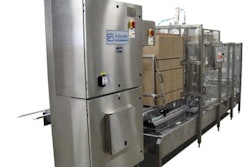Two recent developments affect packagers with an international perspective. One is in China, which has recently taken the next important step in putting in place a new system for clearance of food-contact materials that will affect packagers who want to sell there. Second, back home, a new energy for scrutiny of imported foods and other products will increase packagers’ incentives to be careful with regulatory compliance issues.
Let’s first look at the U.S. side of the equation.
Particularly after 9/11, both unintentional microbial contamination and intentional contamination of the food supply were suddenly a greater concern. Industry groups such as the Grocery Manufacturers’ Association and federal agencies like the Food and Drug Administration quickly put assurance of food safety on the top of their lists. And packaging companies know it, as measures aimed at giving extra attention to quality assurance for food ingredients have increasingly fallen on packaging materials makers as well, a trend that has been noted in this space in the past.
During the Bush Administration, FDA announced an Import Safety Plan in which it called for a series of measures aimed at (1) prevention, (2) intervention, and (3) response. The prevention concept got a further boost when the Food Safety Modernization Act was signed into law in January of this year, with its conceptual emphasis on preventing food contamination before it occurs most notably by requiring more food companies to implement HACCP plans.
Well, FDA added further emphasis to the attention it pays to food imports when, in June, it announced a new approach to safety and quality of imported products of all kinds.
In a report called the “Pathway to Global Product Safety and Quality,” FDA announced its conclusion that it needs a wholesale conceptual change in approach to imports. FDA commissioner Dr. Margaret A. Hamburg announced, “Global production of FDA-regulated products has exploded over the past ten years,” and the U.S. now imports many finished products and also many materials and ingredients. FDA says that in order to more effectively assure safety and quality, it will have to do things like partner-up with its counterpart regulators in other countries and generate and share more data internationally. This emphasis on partnerships echoes a theme in the new Food Safety Modernization Act, under which FDA will arrange for third parties to certify the compliance of foreign food facilities.
Watch for such themes in coming months and years as FDA implements this new philosophy.
As for China’s food-contact materials program, let’s start with a nod to context. With all due respect to the many fine and reputable Chinese manufacturers and suppliers, certainly most observers would agree that in recent years, that nation has suffered from what is, at the very least, a public relations problem. The concept of “food safety” in China has been a matter of “insert-your-joke-here,” as troubling and sometimes bizarre stories seem to be working against the idea that China is effectively entering the modern world. Melamine contamination of pet food products was only the most notorious of a variety of issues, which also included contaminated toothpaste, concerns about seafood, and substandard infant formula and honey.
But China continues to implement changes. Chinese officials say they are moving forward with tougher enforcement of food safety requirements, and they recently passed a detailed food labeling system. Just as important, it continues phasing in a new food-contact materials program.
China’s system essentially grandfathers in older substances that can be supported by safety information, and puts in place a system for approving new substances. Approximately 116 resins and 196 additives have already been cleared by China’s Ministry of Health. Coming soon are listings of additional substances submitted before June 2010 but not included in the original positive list, as a so-called “clean up” submission. As well, there will be a “negative list” coming out, of substances prohibited from food packaging.
In terms of getting new substances cleared, the data required in the ‘dossier’ include what you’d expect: physical and chemical information; technical details about the substance; manufacturing process; quality specifications; test methods and test reports; toxicology; migration or residue and estimated dietary exposure; and other details.
New products would also have to be supported by a Certificate of Free Sale, and Certificate of Good Standing in the country of origin, as well as Chinese translation of the documents, notarized by a Chinese agency.
Once the dossier is submitted, the Ministry of Health will let the applicant know if it is complete within 5 business days. Once complete, they will be reviewed within 60, a relatively quick process.
Whether the issue is the safety of foods imported into the U.S., food contact materials in China, or sales and marketing in other nations around the world, packagers need to continue to be vigilant about international regulatory compliance and safety issues.


























